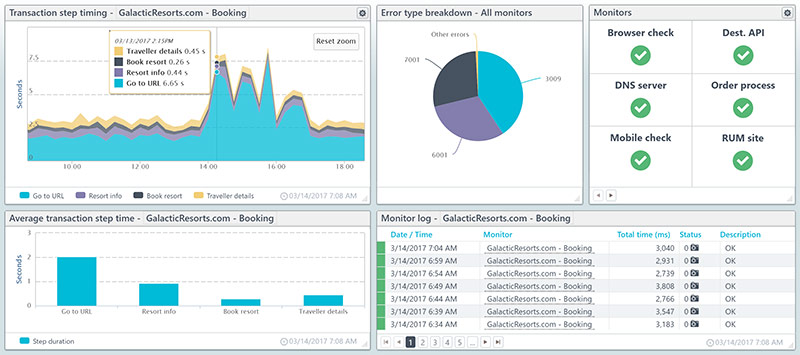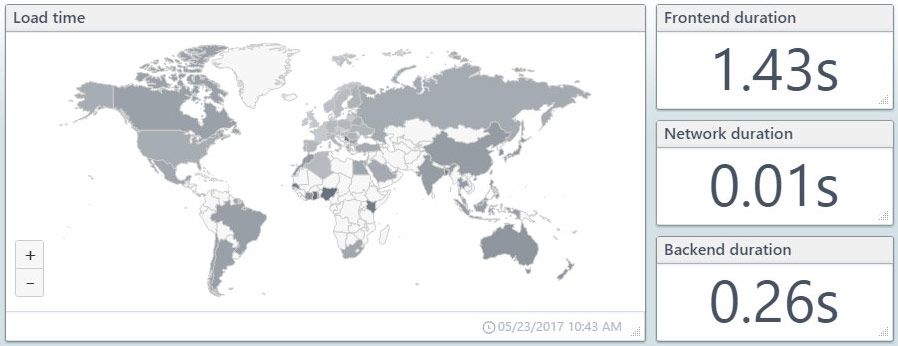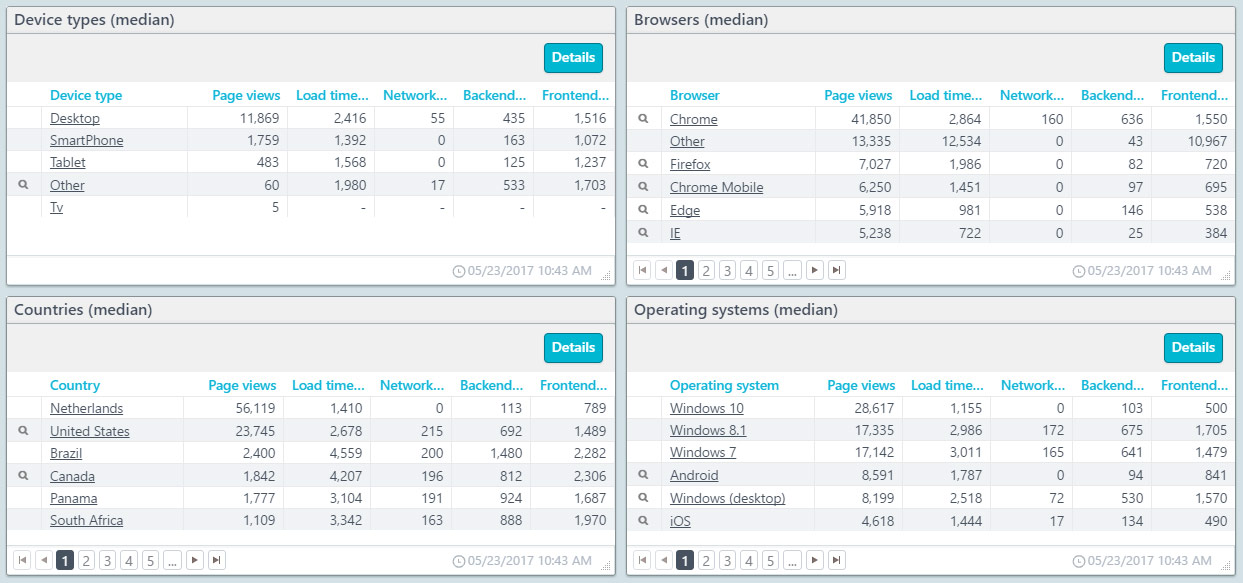You may wonder why you would want to use Real User Monitoring (RUM) and Synthetic Monitoring together. We would like to clear up any confusion you might have in regards to the application of Real User Monitoring and Synthetic Monitoring for protecting your website and improving performance. In this article, we look at six key areas where Synthetic Monitoring and Real User Monitoring differ and complement each other for a holistic approach to your monitoring. First, let’s get a definition for the two monitoring types.
What is Synthetic Monitoring?
Synthetic Monitoring is like a bot. On a regular schedule, our worldwide network of checkpoints interacts with your websites, web applications, and servers and report performance, functionality, and availability information based on a simulated user.

What is Real User Monitoring?
Real User Monitoring reports the performance details for your website based on the actual performance your users experience when accessing your site. The data comes directly from the user; Real User Monitoring simulates nothing. Real User Monitoring captures performance data for every visitor to your site along with information about user location, device type, operating system, and the browser used. You see your data in real time as your users access your site.


Understanding the difference
The best time to react to user issues is before your users experience them, and Synthetic Monitoring gives you that opportunity. With Synthetic Monitoring, you can test your web assets on a continuous basis based on your most common user scenarios to ensure availability and maintain performance. Real User Monitoring reports your user’s experience after they access your website and gives you detailed performance information based on their location, device, operating system, and browser. With detailed performance information about load time, network, backend, and frontend performance from your users, Real User Monitoring allows you to identify trends and fix bottlenecks that may affect all of your users or a subset of users. Synthetic Monitoring and Real User Monitoring together give you the entire performance picture allowing you to maintain a quality experience for all visitors proactively.
Three reasons Synthetic Monitoring complements Real User Monitoring
1. Know your downtime
When your website is up, Real User Monitoring is happily tracking your users’ experiences, but in the event of an outage, you need Synthetic Monitoring. Synthetic Monitoring for advanced availability allows you to test your websites and servers (database, FTP(S), DNS, email) for downtime and receive alerts and reports on your website’s availability. With the detailed availability reports, you can enforce your provider’s SLA or prove to your users that you have met your side of your SLA agreements.
Synthetic Monitoring not only checks for availability and performance but it informs you when your site or servers stop responding or performing in an expected manner. With Synthetic Monitoring, you can check for missing content, page errors, slow response times, DNS and SSL errors, broken functionality, and set up alerts for faster error resolution. Real User Monitoring shows you the results of your hard work and allows you to look at website performance based on your users’ real experiences, but it can’t tell you when your site goes down or transactions start failing.
2. Testing functionality
Real User Monitoring is strictly for performance data, and Real User Monitoring doesn’t provide data about page functionality. With synthetic testing, you can set up a transaction monitor that can test your web forms, logins, and shopping carts and alert you to problems instead of waiting for visitor complaints and reduced revenue.
3. Get to the root cause of Real User Monitoring slowdowns
Both Synthetic Monitoring and Real User Monitoring provide you with performance data, but not in the same way. With Synthetic Monitoring and the Full Page Check, you can get detailed performance information about each page element. Real User Monitoring will help you identify performance problems for specific user scenarios. Replicating that scenario with a Full Page Check allows you to get element-by-element performance data for that scenario leading you to the root cause faster.
Three reasons Real User Monitoring complements Synthetic Monitoring
1. Get performance data for real-world devices and connections that your visitors use
Synthetic Monitoring allows you to simulate real-world connections by altering user agents, throttling bandwidth, and loading your site’s content into real Chrome and Internet Explorer browsers, the two most frequently used browsers. Using the options available to you with Synthetic Monitoring lets you simulate the majority of your users, but in the end, it is still a simulation. Real User Monitoring doesn’t simulate anything, all of your performance data comes from real visitors using real-world devices and connections. You can see exactly how your website responds to your users’ devices with real-time performance data.
2. Get geographical distributions with actual load times
Uptrends has one of the largest checkpoint distributions of any monitoring company with 165 worldwide checkpoints that capture availability and performance for a majority of your users. Real User Monitoring doesn’t rely on checkpoints. In effect, every site visitor becomes a checkpoint. This data lets you know the geographic distribution of your user base, and Real User Monitoring informs you of what devices, operating systems, and browsers site visitors in a given location prefer. Uptrends’ RUM dashboards make it easy to organize your users’ performance data so that you can scrutinize how well your systems support all of your users no matter where they are.
3. Analyze the actual load time, network, backend, and frontend performance of your users’ experience
With the ability to isolate actual user visits based on device, operating system, browser type, and location you can see exactly how the performance breaks down for each group of users. The breakdowns include details about:
- Time to first byte
- Page ready time
- Redirect durations
- DNS duration
- connect time
- Send and receive duration
- DOM and render duration
Synthetic Monitoring uses state-of-the-art machines with current browser versions over super-fast connections. You can change user agents and throttle bandwidth to get an approximation of performance with Synthetic Monitoring, but you still only have a simulation. Real User Monitoring gives you the ability to see the true performance for all users.
Conclusion and the cheat sheet
We hope this article has given you a clear overview of why Real User Monitoring is the perfect addition to your monitor arsenal. Synthetic Monitoring and Real User Monitoring together give you a broad perspective of your users and your site’s availability and performance. We want you to see the value that Real User Monitoring brings to you for yourself, so we have made Real User Monitoring free for the final stages of our beta testing. We put together the following cheat sheet to help you assess your monitoring needs and highlight the real-world challenges and which monitoring type provides a solution.

We have a special section in our Knowledge Base to help you with setup and to answer any questions you might have about Real User Monitoring. Just log into your account and click the blue button at the top of your screen, or sign up for your free 30-day Uptrends trial.





Leave a Reply